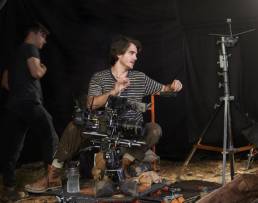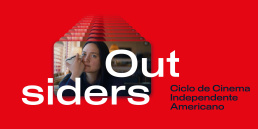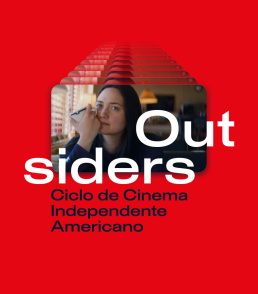American Independent Cinema

Outsiders – American Independent Cinema Series is back for its second edition in Lisbon. From the 7th to the 12th of March, at the São Jorge Theater, FLAD presents a selection of 10 films by independent American filmmakers, never before shown in Portugal, but shown at some of the world´s most prestigious film festivals, many of them winning awards.
In this edition, we revisit “genre films”: melodrama, science fiction, horror, the western, film noir, the biopic…all this and more make up the Outsiders 2023!
Schedule
Masterclass
How I Made Two Feature Films by Age 21
Faculdade de Belas-Artes da Universidade de Lisboa8th of march, Wednesday, Grande Auditório
Little older than a teenager, Jack Fessenden already has two feature films written, directed and premiered in his resumé (in which he also wore the hats of composer, editor and producer). The biological stamp — which he proudly admits — of being Larry Fessenden´s son (one of New York´s independent horror films gurus) would mean nothing without a strong personal contribution (read talent).
Chosen as one of the “11 Great Indie Filmmakers 30 and Under You Need To Know” (Indiewire, 2017), Jack Fessenden was a frequent presence at his father´s studios during his childhood and adolescence, and his curiosity enabled a practical education in the various stages of producing a film. . He made several short films before debuting, at age 17, the feature Stray Bullets, about which Chris O’Falt, in the same Indiewire, said that the most impressive thing was not just the confidence and economy with which the young man treated the choreography of violence, but how he found subtlety and depth in the film´s calmest moments Foxhole, his next work, is more ambitious and inserts itself into the long tradition of the anti-war humanist film, achieving “an almost abstract beauty” (Josh Siegel, MoMA). Fessenden once again skillfully uses the scarce resources available to him, favoring the interactions and moral choices of a group of soldiers in three separate times of war in the history of the United States.
“This kid is going far”, said Meira Blaustein, co-founder of the Woodstock Film Festival. He´s on his way, we would say.

JackFessenden
Movies
Our wish is to share the wave of American independent films still not seen in our theaters, and, at the same time, show a possible portrait of contemporary America. This time around, through the filter of “genre” films.
By Carlos Nogueira, Curator
A melodrama, a science fiction film, a western, a film noir, a horror film – all of these make up the second edition of the Outsiders. All of these and a few more… film genres. The term “genre”, as applied to classical American cinema, has a very specific meaning. Musicals, gangster films, biopics, period films, westerns and screwball comedies, were some of the categories of films produced in Hollywood. Many came from literature or other art forms, and some of them had to reach back as far as ancient Greece for their origins. From early on, the studios understood that codifying the style and content of the stories would allow the public to immediately recognize what it was about to see beforehand, even before buying a ticket. It´s important to remember that it was film exhibition business that created the production studios to “feed” the movie theatres. Those films were a very useful complement to artistic and prestigious films, which were often unclassifiable or fit into such generic categories (drama, comedy, etc.), that it wasn´t easy for the masses to recognize the object they were about to see. Burlesque comedy and melodrama do make an appearance during the silent film period, but it was in talkies (sound films), towards the end of the 1920s, that a great deal of the genres were codified. Many were the studios, directors, screenwriters and actors who specialized in a specific genre, which ends up sticking to them and from which it was difficult to free themselves. Throughout the 50s and 60s, the end of the studio era did not bring with it the end of the genre, but it did enable the liberation of the codes, which were generally rather rigid, and allowed for the proliferation of hybrid categories. Some of the genres that defined the glory of the classical period of American cinema began to extinguish themselves, especially in their “pure” form, which can be attributed to several causes, from changes in customs to the disappearance of the industrial machine, which possessed a perfected know-how. Once in a while we get homages, recreations or remakes and, depending on their success, a small nostalgic focus may surge, generally short-lived since the assembly line no longer exists, which makes the production extremely expensive, or simply because times and tastes have changed. Some genres had a life after death, or never really disappeared (science fiction; horror) to the extent that their cultivators knew how to intelligently and opportunistically take advantage of the public´s desire for mystery and the occult. Nevertheless, independent cinema has utilized, more or less discreetly, those categories and their codes to speak to topics that concern new generations on their own terms and through their own methods. In our selection for Outsiders II, we sought examples of how post-millennium filmmakers reworked Hollywood´s classical era genres. Madeline’s Madeline, by Josephine Decker, which deals with the relationship between mental health and the stage arts, would not have the same impact without it´s references to the musical. In Depraved, Larry Fessenden reinvents the myth of Frankenstein in Brooklyn: references to bodily modifications and their potential dangers? The film noir codes are used with precision by Aaron Katz in Gemini, his reflection on Hollywood and success. In the western In a Valley of Violence, echoes of contemporary society´s violence resonate in the frequent explosions of the western´s violence. The enclosed space of the trenches reveals the importance of solidarity, while simultaneously touching upon the wound of racial prejudice, in the curious contemporary version of the war film Foxhole. The dangers of scientific experiments and how fraudulent manipulations are performed, establish the departure point for the beautiful and mysterious Science fiction film Upstream Color.
The familiar melodrama is reinvented by Trey Edward Shults with the return of Krisha to the family bosom for one day, after a long period of absence due to problems of addiction and mental instability. Though technically a period film, Wild Nights with Emily takes an iconoclastic approach to the biopic, using humor to address questions related to the writer Emily Dickinson´s sexuality. . Drug trafficking had for a long time replaced prohibition as the center of activity for gangsters in the films that made James Cagney and Edward G. Robinson stars; Transpecos travels to the border of no-man´s land and intertwines it with other types of trafficking which take advantage of the human drama of illegal immigration. One of the most characteristic and amusing subgenres of the 30s and 40s — the comedy of remarriage — was derived from sophisticated comedy and was built around the central couple´s reunion after a divorce or separation. In The Lovers, Azazel Jacobs had the genius stroke of putting Debra Winger in a role that in another time would have belonged to Katharine Hepburn, Claudette Colbert or Barbara Stanwyck, while at the same time reflecting on feminism, freedom and interdependence.
Our wish is to share the wave of American independent films still not seen in our theaters, and, at the same time, show a possible portrait of contemporary America. This time around, through the filter of “genre” films.
Carlos Nogueira, curator
Useful Information
Cinema São Jorge
Avenida da Liberdade, nº175
1250-141 Lisbon
Tickets
4,50 €
With discount – 4,00€*
* (under 25 years old, over 65 years old)
How to get there?
Metro
Blue Line | Station: Avenida
Bus
709, 711, 732, 736
Contacts
Press:
Paris, Texas — Rita Bonifácio – ritaparistexas@gmail.com
Other Informations:
media@flad.pt
Sessions for M/14
- Films subtitled in Portuguese
- Program subject to changes
- No reserved seats
Exhibition Credits
Programmer
Carlos Nogueira
Production Coordination
João Romãozinho
Production
Clélia Luiz, Filipa da Rocha Nunes, Rui Vallêra
Communication Coordination
Liliana Valpaços, Rita Bonifácio
Communication
Inês Braizinha, Nuno Martins, Constança Diogo
Press
Paris, Texas (Rita Bonifácio)
Graphic Identity
atelier-do-ver
Communication Design, Web Design and Video
WSA Creative Agency, Pedro Fernandes
Translation
Elsa Vieira
Photography
Joanna Linda
Video Spot
Giuliane Maciel
Acknowledgments
António Pinto Ribeiro
FLAD
FLAD’s Governing Bodies | Board of Trustees
Bernardo Pires de Lima
Maria Teresa Ferreira Soares Mendes
Ana Isabel dos Santos Figueiredo Pinto
Maria Gabriela da Silveira Ferreira Canavilhas
Mário Nuno dos Santos Ferreira
Jack (Joaquim) M. Martins
Management Board
Rita Faden da Silva Moreira Araújo, President
Elsa Maria Pires Henriques
Michael Alvin Baum Jr.
Vítor Ângelo Mendes da Costa Martins
Rodrigo Vasconcelos de Oliveira
Executive Council
Rita Faden da Silva Moreira Araújo, President
Elsa Maria Pires Henriques
Michael Alvin Baum Jr.
CINEMA SÃO JORGE
Director
Marina Sousa Uva
Deputy Director
Inês Freire
Technical coordination
Fernando Caldeira
Deputy technical coordination
Diogo Viana
Projectionists
Carlos Souto
Jorge Silva
Show technicians
Carlos Rocha
Pedro Moreira
Communication
Francisco Barbosa
Pedro Vieira
Home Front Coordination
Diana Liberal Guedes
Administrative Technician
Catarina Bernardo
Ticket Technicians
Carina Rodrigues
Carolina Liberal
Mariana Guimarães
Soraia Souto
Olena Pikho
Maintenance
Mário Silva
Programmer
Carlos Nogueira
Production Coordination
Vítor Alves Brotas | Agency 25
Production
Clélia Luiz, Filipa da Rocha Nunes, Rui Vallêra
Communication Coordination
Inês Lampreia, Liliana Valpaços
Communication
Inês Braizinha, Mariana Nunes, Nuno Martins
Press
Helena César
Graphic Identity
atelier-do-ver
Communication Design, Web Design and Video
Translation
Elsa Vieira
Photography
Joanna Linda
Acknowledgments
António Pinto Ribeiro
CINEMA SÃO JORGE
Director
Marina Sousa Uva
Deputy Director
Inês Freire
Technical coordination
Fernando Caldeira
Deputy technical coordination
Diogo Viana
Projectionists
Carlos Souto
Jorge Silva
Show technicians
Carlos Rocha
Pedro Moreira
Communication
Francisco Barbosa
Pedro Vieira
Home Front Coordination
Diana Liberal Guedes
Administrative Technician
Catarina Bernardo
Ticket Technicians
Carina Rodrigues
Carolina Liberal
Mariana Guimarães
Soraia Souto
Maintenance
Mário Silva


























